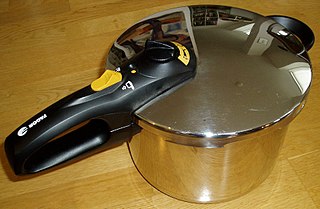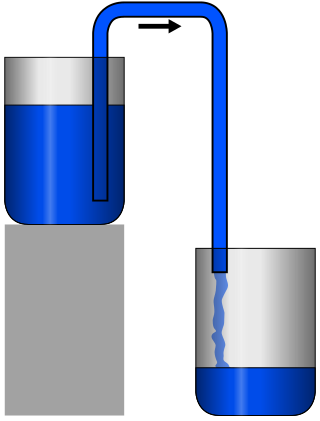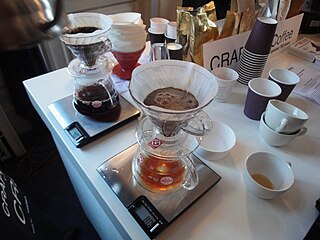


A milk watcher, milk saver, pot watcher, pot minder, milk guard, or boil over preventer is a cooking utensil placed at the bottom of a pot to prevent the foaming boil-over of liquids by collecting small bubbles of steam into one large bubble.



A milk watcher, milk saver, pot watcher, pot minder, milk guard, or boil over preventer is a cooking utensil placed at the bottom of a pot to prevent the foaming boil-over of liquids by collecting small bubbles of steam into one large bubble.
A milk watcher is a disk with a raised rim notched on one side. Some milk savers are designed so they can be used with the obverse or reverse side facing up and appear to have two notches. The interior of the disk slants upward toward the notched side, creating a space just behind the notch where water vapor can collect. Water vapor trapped under the milk saver causes the notched side to rise up, releasing the water vapor and making a rattling noise as the saver falls back into contact with the base of the pan. [1] [2]
Normally, boiling water does not boil over. When fats, starches, and some other substances are present in boiling water, for example by adding milk or pasta, boiling over can occur. A film forms on the surface of the boiling liquid; for example, cream can boil over as milk fat separates from the milk. [3] The increased viscosity of the liquid causes the steam bubbles to form foam trapped under the film, pushing the film up and over the lip of the pot, boiling over. A milk watcher disrupts this process by collecting small bubbles of steam into one large bubble and releasing it in a manner which may puncture the surface film. The device also rattles when boiling occurs, alerting the cook who may then lower the heat setting of the stove.
By circulating fluid around the bottom of the pot the device may also prevent material from being deposited and eventually burned on the pot's bottom. [4]
The milk watcher was invented by I. F. Ivankovitser in 1921; a patent was obtained in 1929. [5] It was reinvented by Vincent Hartley in 1938. [6]

A bain-marie, also known as a water bath or double boiler, a type of heated bath, is a piece of equipment used in science, industry, and cooking to heat materials gently or to keep materials warm over a period of time. A bain-marie is also used to melt ingredients for cooking.

Distillation, also classical distillation, is the process of separating the component substances of a liquid mixture of two or more chemically discrete substances; the separation process is realized by way of the selective boiling of the mixture and the condensation of the vapors in a still.

Boiling or ebullition is the rapid phase transition from liquid to gas or vapor; the reverse of boiling is condensation. Boiling occurs when a liquid is heated to its boiling point, so that the vapour pressure of the liquid is equal to the pressure exerted on the liquid by the surrounding atmosphere. Boiling and evaporation are the two main forms of liquid vapourization.

Pressure cooking is the process of cooking food under high pressure steam and water or a water-based cooking liquid, in a sealed vessel known as a pressure cooker. High pressure limits boiling and creates higher cooking temperatures which cook food far more quickly than at normal pressure.
In thermodynamics, superheating is the phenomenon in which a liquid is heated to a temperature higher than its boiling point, without boiling. This is a so-called metastable state or metastate, where boiling might occur at any time, induced by external or internal effects. Superheating is achieved by heating a homogeneous substance in a clean container, free of nucleation sites, while taking care not to disturb the liquid.

A siphon is any of a wide variety of devices that involve the flow of liquids through tubes. In a narrower sense, the word refers particularly to a tube in an inverted "U" shape, which causes a liquid to flow upward, above the surface of a reservoir, with no pump, but powered by the fall of the liquid as it flows down the tube under the pull of gravity, then discharging at a level lower than the surface of the reservoir from which it came.

A slow cooker, also known as a crock-pot, is a countertop electrical cooking appliance used to simmer at a lower temperature than other cooking methods, such as baking, boiling, and frying. This facilitates unattended cooking for many hours of dishes that would otherwise be boiled: pot roast, soups, stews and other dishes.

A rotary evaporator (rotavap) is a device used in chemical laboratories for the efficient and gentle removal of solvents from samples by evaporation. When referenced in the chemistry research literature, description of the use of this technique and equipment may include the phrase "rotary evaporator", though use is often rather signaled by other language.

Boxty is a traditional Irish potato pancake. The dish is mostly associated with the north midlands, north Connacht and southern Ulster, in particular the counties of Leitrim, Mayo, Sligo, Fermanagh, Longford, and Cavan. There are many recipes but all contain finely grated, raw potatoes and all are served fried.

Churning is the process of shaking up cream or whole milk to make butter, usually using a device called butter churn. In Europe from the Middle Ages until the Industrial Revolution, a churn was usually as simple as a barrel with a plunger in it, moved by hand. These have mostly been replaced by mechanical churns.

The following outline is provided as an overview of and topical guide to the preparation of food:
The Marcusson apparatus, Dean-Stark apparatus, Dean–Stark receiver, distilling trap, or Dean–Stark Head is a piece of laboratory glassware used in synthetic chemistry to collect water from a reactor. It is used in combination with a reflux condenser and a distillation flask for the separation of water from liquids. This may be a continuous removal of the water that is produced during a chemical reaction performed at reflux temperature, such as in esterification reactions. The original setup by Julius Marcusson was refined by the American chemists Ernest Woodward Dean (1888–1959) and David Dewey Stark (1893–1979) in 1920 for determination of the water content in petroleum.

Microfoam is finely textured milk used for making espresso-based coffee drinks, particularly those with latte art. It is typically made with the steam wand of an espresso machine, which pumps steam into a pitcher of milk.

Coffee preparation is the process of turning coffee beans into liquid coffee. While the particular steps vary with the type of coffee and with the raw materials, the process includes four basic steps: raw coffee beans must be roasted, the roasted coffee beans must then be ground, and the ground coffee must then be mixed with hot or cold water for a specific time (brewed), the liquid coffee extraction must be separated from the used grounds, and finally, if desired, the extracted coffee is combined with other elements of the desired beverage, such as sweeteners, dairy products, dairy alternatives, or toppings.

A vacuum coffee maker brews coffee using two chambers where vapor pressure and gravity produce coffee. This type of coffee maker is also known as vac pot, siphon or syphon coffee maker, and was invented by Loeff of Berlin in the 1830s. These devices have since been used for more than a century in many parts of the world. Design and composition of the vacuum coffee maker varies. The chamber material is borosilicate glass, metal, or plastic, and the filter can be either a glass rod or a screen made of metal, cloth, paper, or nylon. The Napier Vacuum Machine by James Robert Napier, presented in 1840, was an early example of this technique. While vacuum coffee makers generally were excessively complex for everyday use, they were prized for producing a clear brew, and were quite popular until the middle of the twentieth century. Vacuum coffee makers remain popular in some parts of Asia, including Japan and Taiwan. The Bauhaus interpretation of this device can be seen in Gerhard Marcks' Sintrax coffee maker of 1925.
A climbing/falling film plate evaporator is a specialized type of evaporator in which a thin film of liquid is passed over a rising and falling plate to allow the evaporation process to occur. It is an extension of the falling film evaporator, and has application in any field where the liquid to be evaporated cannot withstand extended exposure to high temperatures, such as the concentration of fruit juices.

A multicooker is an electric kitchen appliance for automated cooking using a timer. A typical multicooker is able to boil, simmer, bake, fry, deep fry, grill roast, stew, steam and brown food.

A milk frother is a utensil for making milk froth, typically to be added to coffee. It aerates the milk, creating a thick but light foam. Milk frothers were introduced through the use of espresso machines that contained steamed wands that would froth steamed milk. Although created in Italy, the espresso machine and steam wands were exported internationally to other countries, and frothed milk was introduced around the world.
{{cite web}}: CS1 maint: bot: original URL status unknown (link) ![]() Media related to Milk watcher at Wikimedia Commons
Media related to Milk watcher at Wikimedia Commons